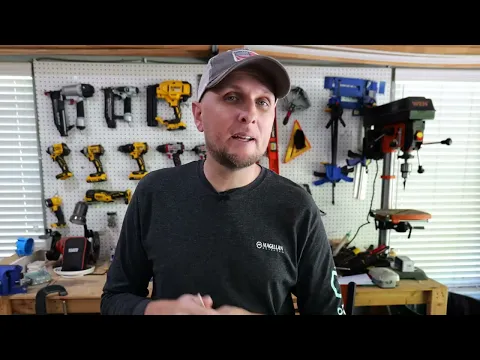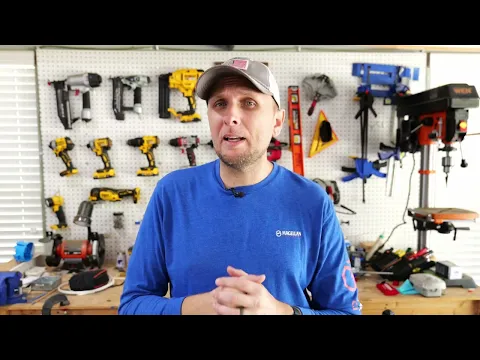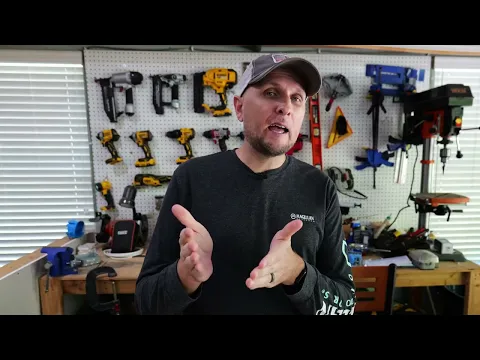7 FATAL Wiring Mistakes Most DIYers Don't Know They Are Making | Most Are Guilty of 3
Apr 12, 2024We're going to go over some of the biggest
common connection that is made, we are going to start with a solid core to a solid core, so what
people do when
mistakes
that DIYers, and yes, some electricians, make when connecting wires, and of course, we'll go over how to connect them correctly and some best practices as well, so let's go ahead and Skip to the right Let's go to go well, so because this is themost
common connection that is made, we are going to start with a solid core to a solid core, so what most
people do when they
connect cables is take their two cables thethey
're going to put them next to each other and then they're just going to take their wire nut and they're going to put it on top of it and then they're going to tighten it down to where they get some resistance and then they're going to call Okay, well the problem with this is that while these two wires are inside the wire nut, they are currently connected, this was not done according to the manufacturer's instructions, but when you just turn them you will not get that connection and you could run the risk of it actually being a loose connection and over time one of these wires could fall out , so to give you a demonstration while no one will be on your wall pulling the wires, the wires vibrate due to the current. flowing through them and that's why they can eventually fall out over time if you don't have a good tight connection using a wire nut, this is what can happen, so while both wires were connected under this wire nut, the problem again is the instructions on how they should have been installed were not followed and we were completely relying on the wire nut to make the connection and hold these wires together so if you don't believe the pre-twisting let me at least show you what the manufacturer says it should look like when you just use the wire nut to twist it you see how the two wires are next to each other, now it's a solid wire and it's stranded but it's the same for the solid core where we'll have them side by side from the other and then you're going to want to have this nice twist under the wire nut and the reason for that is this, so let's go ahead and put the wire nut back on and turn this.According to the instructions that we saw on the package, as you can see, I have a nice braid under the wire nut, not only will you have support to hold the wires together down here, but if we take this wire. The nut was removed or for some reason this wire nut just fell off once we removed the wire nut as you can see because we turned it the way we did a joint formed between these two cables where they are essentially attached. together, they don't rely on the wire nut to hold them together, they are completely braided under the wire nut, so you
know
you're going to have a really good connection and again, there's no way they're just going to fall apart.
More Interesting Facts About,
7 fatal wiring mistakes most diyers don t know they are making most are guilty of 3...
This is a good and acceptable method, but let me show you which method is preferred by many electricians. This is what many electricians will do: they will remove a little more insulation than they normally would. lineman's pliers and they will do what I've already mentioned, but they will do what is called pre-twisting and the reason they do this is again they
know
that this will form a nice tight joint where those wires are. it doesn't rely on the wire nut to hold it together and you know you're going to have a lot of contact surface between the wires and also by doing this before you put the wire nut on, you'll be able to verify that in fact you have a very tight joint between the wires and then they would just cut off the top, then take a wire nut and then put it on top, so in this case, by pre-twisting, the wire nut is mainly used as an insulator to secure. that those hot wires don't touch anything they shouldn't and while these wires don't necessarily need the help of the wire nut holding them together, it still helps reinforce that nice, tight bond under the wire nut, now this mistake is one that I see almost all the time that uses the wrong wire nut for the job, so in this case I have this yellow Ideal wire nut and I have four number 12 wires and what someone will do is they take wires that are too big and the amount is too much for the wire nut that they are using, but somehow they will find a way to be able to fit all those wires into that wire nut like this, so we have all of our wires nothing is falling out, but I can guarantee you that this wire nut cables is very overloaded and one of these cables is going to be extremely easy to pull out and there is that, the first clue that you are overloading a wire nut, it is going to be very difficult to get all the wires to show inside the nut to wires and then once you put a wire nut on you should always pull the wires and if you have overloaded a wire nut you will most likely get the result that I got where this one could be pulled out very easily.Now, on the other hand, someone could be using one of these larger blue wire nuts and say they have two 12 gauge. Well, the wires will go, they'll put their wires in the wire nut, they'll go and tighten them, as you can see , they are not only falling down, but with any force they are pulling on one of these. The wires are just going to fall out, so the minimum size you can fit in this blue wire nut is 12 gauge wire, but with a minimum of at least three wires and it's incredibly easy to tell what your nut is capable of. for cables.
Every package you can buy at the wire nut store will have this bar graph on the back or sometimes the side that will list exactly what size wire will fit that particular color and type. of wire nut and then also the quantities of that size and then it will give you the minimums and maximums of each of the different wire nuts in the packaging. Now I'm about to get into a really important tip, so don't go anywhere, but real quick, if you could do me a big favor if so far you're finding value in this video, if you could hit the thumbs up button that's right below or leave me a comment in the comments section about what you think about it.
It really helps spread the video to other people and hopefully help them too. I really appreciate it. Let's get back to it, so the next one is an incredibly common connection that needs to be made and it's between strong. Core and braid. I would say this is probably the hardest to get right and probably one of the most common to fail, so most of the time you have the solid core cable all over the house and then you may have to install it as a light fixture or a ceiling fan and they almost always come with this braided wire and with the fixture they usually include some type of wire nut like this that often aren't necessarily designed to help promote twisting of the wires. under the wire nut, so what most people will do is take their two wires and they'll just put them next to each other and then they'll take their shitty wire nut and then they'll put it on top here is where it's really not that uncommon that we see problems popping up, so let's turn this wire nut back on and as you can see, as we had the two wires next to each other when they put the wire nut on it.
You can see that that stranded wire is now underneath the solid core wire and this almost always happens and that's why it's so important to make sure you follow the instructions because the instructions would have told you to do something a little different and so on. We might think that we have a good connection here because we tightened it pretty tight, it's actually not that hard to get that braided wire out of there and as you can see from the braided wire, it didn't even try to make a connection. try to wrap around the solid core wire, so the easiest way to do this is if we take our two conductors here, we want our stranded wire to be a little bit longer than the solid core wire at our starting point before we get the Attach the wire nut so now let's go ahead and instead of using a poor quality wire nut like this one it's always better to use a name brand wire nut like this one that is made by ideal because they simply do a better job at wrap the wires, so let's go. go ahead and put them in there and tighten them down and like we've done before we want to make sure we keep tightening them down to where we have a nice wrap under the wire nut all good so we've got a little bit of a good wrap under the wire nut , there's just no way that wire is ever going to come out of that wire nut, it's getting support from the winding here under the wire nut and then let's go ahead and remove the wire nut. and you'll see this time the stranded wire is up there, as long as the solid core conductor is and it's also trying to wrap around that solid core conductor for the most part, you'll probably never have a problem with this connection here, but especially When it comes to connecting a stranded core to a solid core, another very good option to use would be these Wago lever nuts here and they are great, especially for this circumstance, because you don't have to worry about those wires twisting around each other and, While they can be incredibly easy to use, we're going to go over some errors that I've seen and some of the problems that come with those errors and then also how to fix them, so of course the way they work is that they have these levers on them.
Just lift them up to insert the cables into the ports here, so we'll go ahead and insert our cables. Once the cable is there, you can just flip it down and now at this point these cables are ready to be. pushed back into a box and that's where I've seen a big problem arise: when people push them to the back of the box, the only thing they focus on is trying to get all the cables into the box, Sometimes it can be difficult to do, there have been cases where these levers get caught on the cables and because you push so hard the lever lifts up and unbeknownst to the installer they think everything is connected and you are ready to install your new device, when in reality one of your cables is not secured at all and can fall out, so it is very important that when you go to push them towards the back of a case, I like to put my fingers on the levers as I push them back into that box. and I won't take my thumb off those levers until I have the cables routed the way I want them.
Now another option that can be taken is to take some electrical tape and just wrap it around the Wago
making
sure that We're going over those levers and this way the levers can't be lifted up even if you wanted to, the next mistake I see being made is that people will be installing theirwiring
, so we'll go ahead and push them into each of the The ports pull down the levers now that those wires are connected, but as you can see, we've removed too much insulation from the wires and this can be dangerous in a box where it could cause arcing.This is an unsafe installation that could actually lead to a fire, on the contrary I have seen someone remove very little insulation from one or both wires and then put their wires in the Wago and although there is nothing exposed here and everything appears to be sure and we probably won't have any fire start from this I'll show you what can happen so we have our connection made and this Wago here and this is the wire where not enough insulation was cut so what will happen is that someone thinks they have installed everything correctly, they will turn on the circuit breaker, maybe take a non-contact voltage detector and just see if they have power there, which look, we have power going to that conductor there, but then they wonder why when the receptacle that they connected to this wire or the light switch that is connected to this wire does not work, is not receiving power or maybe just works fine intermittently while there is no contact.
The voltage detector tells us that we have power here, let's use a multimeter and see what's really there, so again our non-contact voltage detector tells us that we have active voltage there, but when we go to test it with a multimeter. It's showing that we're only getting like four and a half volts, so you may have active power flowing through the wires and your non-contact voltage detector could tell you that you have power flowing through it, which it does, but it doesn't. It's like that. have enough voltage or at least a consistent enough voltage depending on how the wires are to power the things you want to power, so how can we avoid all of these problems if we flip it here to the side on these bums?
You will see that there is a strip meter right here and as long as you remove the insulation to be as long as this strip meter shows, you will know for sure that you are removing the proper amount of insulation and ensuring a good connection. So obviously in electricity it's very important to make sure you make good connections and that's not just with the cables,but also with any devices you'll be installing, like receptacles or light switches, so if you want. To learn more about some of the biggest
mistakes
made when installing those devices, and of course also how to best install them, I'll post a link to a video right here.If you click on it now, it will take you directly. to it if I don't hope that you found value in this video and if you did, if you could do me a big favor, hit the thumbs up button right below and of course if you still have any questions or comments you can leave them in the comments section and I will respond. See you all next time.
If you have any copyright issue, please Contact









